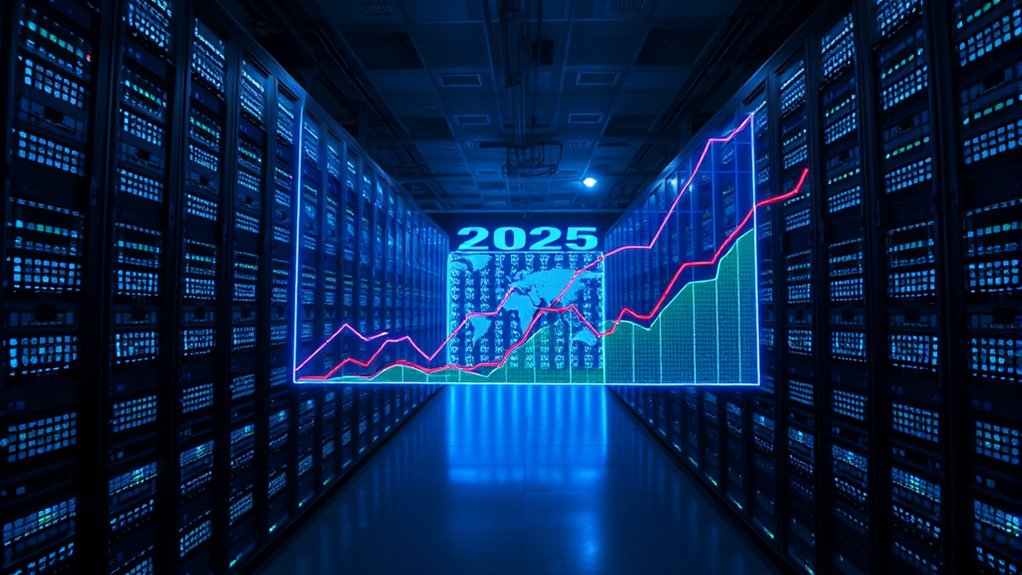2025 stands out because cybercriminals use more sophisticated, AI-driven techniques to attack, exploit third-party vulnerabilities, and exfiltrate data faster than ever. Major breaches target not just large corporations but also supply chains and SaaS platforms, increasing the attack surface. The economic impact hits trillions globally, with healthcare, finance, and manufacturing hardest. If you want to understand why these trends are shaping this record-breaking year, there’s more to uncover ahead.
Key Takeaways
- 2025 saw a surge in high-profile breaches exploiting third-party vendors and supply chain vulnerabilities.
- Attackers increasingly used AI-driven methods to automate, accelerate, and evade traditional security defenses.
- The economic impact of breaches reached over $10.5 trillion globally, with sectors like healthcare and manufacturing heavily affected.
- Sophisticated attack techniques combined ransomware, data exfiltration, and stealthy exports, raising breach complexity.
- Enhanced detection and response strategies, including behavioral analytics and automation, became vital in mitigating damage.
The Surge in High-Profile Breaches and New Attack Vectors

This year has seen a sharp increase in high-profile data breaches, with cybercriminals employing new attack vectors to target even the most secure organizations. You probably noticed major companies like PowerSchool, SK Telecom, and Qantas falling victim, exposing millions of records. Hackers now exploit weaknesses in third-party systems, SaaS token misuse, and supply chain vulnerabilities, allowing large-scale breaches without directly breaching networks. AI-driven attacks have become more sophisticated, speeding up intrusion methods and evading traditional defenses. Misconfigurations and stealthy data exports enable hackers to leak vast amounts of information quietly. Additionally, the rise of Remote Hackathons has facilitated collaboration among cybercriminals across borders, further complicating efforts to combat these threats. These evolving tactics make it clear that cybercriminals are continuously adapting, using innovative techniques to bypass security measures, ensuring breaches remain frequent and damaging at an unprecedented scale. The increasing sophistication of encryption techniques used by defenders highlights the ongoing arms race between attackers and security professionals.
The Growing Role of Third-Party Vendors and SaaS Exploits

You need to recognize how vendor access vulnerabilities and SaaS token exploits are increasingly fueling large-scale breaches. Attackers target supply chain weaknesses to gain entry, often exploiting trusted third-party systems. As a result, protecting your organization requires strengthening third-party controls and monitoring SaaS security more closely. Supply chain weaknesses are also a common entry point for attackers, emphasizing the need for comprehensive security practices. Strengthening third-party controls can mitigate these risks and improve overall security posture. Refrigerant management is also critical, as it impacts system efficiency and environmental safety, highlighting the importance of comprehensive security practices. Implementing consistent cookie consent management helps ensure compliance and enhances overall security posture. Additionally, understanding the different types of home furnishings can contribute to creating safer, more comfortable environments that support overall well-being.
Vendor Access Vulnerabilities
As organizations increasingly rely on third-party vendors and SaaS platforms, vulnerabilities in these external access points have become a leading cause of data breaches. Attackers exploit weak security controls, misconfigured permissions, and inadequate vendor oversight to gain unauthorized access. Once inside, they can move laterally, exfiltrate sensitive data, or deploy malware, often without detection. SaaS token exploits, in particular, enable hackers to hijack session credentials, bypassing traditional defenses. Many organizations overlook the risks posed by third-party integrations, leaving gaps that cybercriminals can easily target. As breaches grow more sophisticated, it’s essential to implement strict vendor management, continuous monitoring, and robust authentication protocols. Regular security audits can help identify and remediate vulnerabilities in external access points, significantly reducing your exposure to costly, large-scale data leaks. Recognizing AI-driven attack methods is crucial for staying ahead of evolving cyber threats.
SaaS Token Exploits
SaaS token exploits have become a prominent method for cybercriminals to access organizational data through third-party vendors. Attackers target weak or stolen tokens to bypass authentication and infiltrate cloud platforms, often without detection. This method allows them to move laterally across systems, accessing sensitive information or deploying malware. Implementing proper residency requirements and security protocols can help organizations mitigate these risks.
Here are three key points to understand:
- Token theft often occurs via phishing or malware, giving attackers quick access without needing passwords.
- Misconfigured permissions enable unauthorized token use, increasing breach risks.
- Third-party vulnerabilities amplify exposure, as compromised vendors can serve as launchpads for larger attacks.
Staying vigilant about SaaS token security is vital, as these exploits continue to grow in sophistication and scale.
Supply Chain Risks
The increasing reliance on third-party vendors and cloud-based services has considerably expanded the attack surface for cybercriminals. You become more vulnerable when hackers exploit vulnerabilities within your suppliers’ systems or SaaS platforms, often gaining access through trusted connections. These breaches can cascade, exposing your data and disrupting operations without directly attacking your core network. Attackers increasingly target supply chain points because they offer a shortcut to large-scale access, often hiding behind legitimate vendor credentials. If you’re not thoroughly vetting and monitoring your third-party partners, you risk unknowingly giving hackers a foothold. Managing supply chain risks requires rigorous security assessments, strong contractual controls, and continuous oversight of vendor security practices to prevent exploitation and minimize potential damage. Incorporating glycolic acid products into your skincare routine can help improve skin resilience, which is crucial when managing exposure to environmental stressors and maintaining overall health.
Changing Cost Dynamics and Economic Impact of Data Incidents

You’ll notice that the financial burden of data breaches keeps growing, with global costs estimated to hit $10.5 trillion annually. While the average breach cost has decreased slightly, the rise in regulatory fines and detection expenses in the US pushes overall spending higher. These shifting cost dynamics highlight how the economic impact of data incidents continues to escalate worldwide. Additionally, the increased use of sophisticated detection methods like Eye Patch Benefits and monitoring tools underscores the importance of investing in advanced security measures. Incorporating self watering plant pots and eco-friendly solutions can also help organizations demonstrate their commitment to sustainability and innovation in cybersecurity practices. Emphasizing space management within cybersecurity infrastructure can lead to more efficient resource allocation and quicker response times. Recognizing the significance of cost management strategies can further aid organizations in controlling expenses amidst rising breach-related costs.
Rising Financial Burdens
Despite improvements in breach detection and response, the financial toll of data incidents continues to escalate. Costs are rising even as organizations get faster at identifying breaches. Here’s what’s driving the financial burdens:
- The US now faces an average breach cost of over $10 million, fueled by regulatory fines and complex recovery efforts.
- Ransomware attacks cost victims an average of $1.85 million, with rising frequency increasing overall expenses.
- The global economic impact hits an estimated $10.5 trillion annually, reflecting the widespread financial disruption caused by breaches.
You’re dealing with not just direct costs but also long-term consequences, including regulatory penalties, reputational damage, and operational disruptions, all adding to the financial strain.
Escalating Global Costs
As data breaches become more frequent and sophisticated, their financial impact continues to grow exponentially on a global scale. You’ll notice that the average cost per breach has slightly decreased to $4.44 million, but the worldwide losses are soaring to an estimated $10.5 trillion annually. The U.S. alone faces an average breach cost of $10.22 million, driven by regulatory fines and detection expenses. Cybercriminals now target third-party vendors and exploit SaaS tokens, amplifying damage without direct network intrusion. Meanwhile, ransomware attacks cost victims an average of $1.85 million per incident. The global economy bears the heavy toll of breaches, with cybercrime costs estimated at $333,000 per minute, underscoring how essential it is to strengthen defenses and improve detection to mitigate these escalating costs. Incorporating comprehensive whole-house security measures can help reduce vulnerabilities across interconnected systems and minimize overall financial impact.
Evolving Tactics: Ransomware, Data Exfiltration, and AI-Driven Attacks

How have cybercriminals evolved their tactics to maximize damage in today’s threat landscape? They now combine sophisticated ransomware, data exfiltration, and AI-driven attacks to increase impact. Here are three key developments:
- Ransomware operators now exfiltrate data before encryption, putting additional pressure on victims to pay.
- Data theft is often stealthy, using misconfigurations and silent exports to leak large volumes without detection.
- AI enhances attack complexity, with about one in six breaches involving AI tools to automate and accelerate intrusion steps.
- The use of raw data in attack strategies enables more targeted and effective breaches, increasing the potential for damage.
- Cybercriminals are increasingly exploiting regional vulnerabilities and local configurations to tailor attacks and evade detection.
- Incorporating specialized knowledge from fields such as automotive tuning allows attackers to craft more convincing and tailored attack vectors, making defenses more challenging.
- Attackers are also leveraging data analysis techniques to identify the most vulnerable points within organizations, further improving their success rates.
- The ongoing integration of AI security technologies into cyberattack strategies demonstrates the growing sophistication and adaptability of threat actors.
These tactics make breaches more damaging and harder to defend against, forcing organizations to adapt quickly. Staying aware of these evolving methods is vital to strengthen your defenses and reduce the risk of falling victim.
Sector-Specific Vulnerabilities and Rising Industry Risks

Certain industries face heightened risks due to their unique vulnerabilities and the evolving tactics of cybercriminals. Healthcare remains the most costly sector, with sensitive patient data making it a prime target for ransom and espionage. The industrial sector has seen the largest increase in breach costs, driven by operational disruptions and legacy system vulnerabilities. Telecommunications and education sectors face rising exposures from sophisticated supply chain attacks and third-party vulnerabilities. Aviation and manufacturing are increasingly targeted for their interconnected systems and valuable data. Small and medium businesses, often lacking robust defenses, are targeted nearly four times more than large enterprises. Industry-specific weaknesses, combined with new attack methods, mean that each sector must prioritize tailored security measures to mitigate these growing risks effectively.
Improvements in Detection and Response Strategies

Improved detection and response strategies have markedly shortened the time organizations take to identify and contain data breaches. This progress helps limit damage and reduces costs. You can enhance your defenses through several key tactics:
- Implement AI and automation tools to detect threats faster and alert your team within hours, not days.
- Regularly update and patch vulnerabilities to prevent exploitation of known weaknesses.
- Use advanced monitoring techniques, like behavioral analytics, to identify unusual activity early.
These measures have led to a decrease in breach detection time to an average of 241 days. Organizations deploying AI detection cut their response times by 80 days, saving nearly $1.9 million per incident. Staying proactive with these strategies can considerably impact your breach response effectiveness.
Key Takeaways: Lessons Learned From 2025’s Data Breach Landscape

2025 has underscored the importance of proactive security measures and the evolving tactics of cybercriminals. You’ve learned that relying solely on detection isn’t enough; prevention is vital. Third-party vulnerabilities, misconfigurations, and AI-driven attacks now dominate breach methods. To stay ahead, implement layered defenses like multi-factor authentication, vendor isolation, and regular patching. Staying informed about attack trends helps you adapt quickly. Here’s a quick overview:
| Key Focus | Lesson Learned | Action Step |
|---|---|---|
| Third-party risks | Vendors are prime attack targets | Tighten third-party controls |
| Evolving Tactics | AI accelerates attack sophistication | Invest in AI-driven security |
| Detection Speed | Faster detection saves millions | Enhance monitoring systems |
Frequently Asked Questions
What New Cyberattack Techniques Emerged Most Prominently in 2025?
In 2025, you see a rise in AI-driven attacks, making breaches more sophisticated and harder to detect. Hackers are exfiltrating data before encrypting systems with ransomware, increasing pressure on victims. Misconfigurations and quiet data exports enable stealthy large leaks, while supply chain and third-party vendor compromises become common. These tactics, combined with stolen credentials and legacy vulnerabilities, make cyberattacks more targeted and complex than ever before.
How Did Breach Costs Vary Across Different Industries This Year?
You’ll notice breach costs vary greatly across industries in 2025. Healthcare remains the most expensive, driven by sensitive data and operational impacts. The industrial sector saw costs rise by around $830,000 on average, reflecting increased targeting. Small and medium businesses face nearly four times higher breach costs compared to large firms, highlighting their vulnerability. Telecommunications, education, aviation, and manufacturing sectors also experienced rising breach expenses due to evolving attack methods.
What Role Did AI Play in the Escalation of Cyberattacks?
Ever wonder how AI has fueled cyberattacks? You see, AI now accelerates attack sophistication by enabling hackers to craft convincing phishing, automate breaches, and develop stealthier malware. It’s involved in about one in six breaches, making attacks faster and more targeted. Does it surprise you that AI’s role increases the risks, pushing defenders to adopt smarter, faster detection methods? Staying ahead means understanding AI’s double-edged sword in cybersecurity.
How Effective Were Detection Improvements in Reducing Breach Impacts?
Detection improvements in 2025 markedly reduced breach impacts by enabling organizations to identify and contain threats faster. You benefit from shorter response times—down to 241 days on average—saving nearly $1.9 million per incident. Automated systems and AI-driven detection play vital roles, allowing you to spot breaches approximately 80 days sooner. These advancements lead to fewer damages, lower notification costs, and enhanced overall security resilience.
Which Third-Party Vulnerabilities Caused the Largest Data Leaks in 2025?
Think of third-party vulnerabilities as open gates inviting hackers in. In 2025, the biggest data leaks came from breaches in SaaS platforms like Salesforce, which exposed millions of customer records, including personal and financial data. Vendor access flaws and token misuses acted like loose locks, allowing cybercriminals to infiltrate. These weak points highlight the importance of rigorous third-party security measures to prevent massive, costly leaks.
Conclusion
As you navigate 2025’s data breach chaos, it’s ironic how the very tools meant to protect us—AI and advanced detection—also fuel new attack methods. You’d think better defenses would mean fewer breaches, but instead, they’ve become the paintbrushes for cybercriminals’ latest masterpieces. So, while you bolster your defenses, remember: in this digital wild west, the more you fight back, the more creative your foes get. Stay vigilant—today’s safeguards might become tomorrow’s vulnerabilities.





